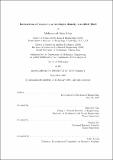| dc.contributor.advisor | Dick K.P. Yue and Yuming Liu. | en_US |
| dc.contributor.author | Alam, Mohammad-Reza | en_US |
| dc.contributor.other | Massachusetts Institute of Technology. Dept. of Mechanical Engineering. | en_US |
| dc.date.accessioned | 2009-08-26T16:33:49Z | |
| dc.date.available | 2009-08-26T16:33:49Z | |
| dc.date.copyright | 2008 | en_US |
| dc.date.issued | 2008 | en_US |
| dc.identifier.uri | http://hdl.handle.net/1721.1/46487 | |
| dc.description | Thesis (Ph. D.)--Massachusetts Institute of Technology, Dept. of Mechanical Engineering, 2008. | en_US |
| dc.description | Includes bibliographical references (leaves 273-282). | en_US |
| dc.description.abstract | In the first part of this thesis, the mechanisms of nonlinear resonant interaction of surface-interfacial waves with a rippled bottom in a two-layer density stratified fluid in two dimensions is investigated via perturbation analyses and direct simulation. Three classes of Bragg resonances are found to exist if the nonlinear interactions up to third order in the wave/ripple steepness are considered. At second order, class I Bragg resonance occurs involving two surface and/or internal waves and one bottom ripple component. At third order, class II and III Bragg resonances occur involving resonant interactions of four wave/ripple components. A powerful high-order spectral (HOS) method for nonlinear gravity wave dynamics in a homogeneous fluid is extended to the case of a two-layer fluid over non-uniform bottom. The method is capable of capturing the nonlinear interactions among large number of surface/interfacial wave mode and bottom ripple components up to an arbitrary high order. As an illustration of the usefulness of the numerical method a somewhat complicated problem involving many wave/bottom components is considered and it is shown that the ensuing multiple (near) resonant interactions result in the generation of multiple new transmitted/reflected waves that fill a broad wavenumber band eventually leading to loss of order and chaotic motion. In the second part of this thesis, Resonance between waves of an oscillating/translating disturbance in two-layer density stratified fluids is studied. Waves in homogeneous fluid are known to be non-resonant at the second order. Many seas and oceans, however, are weakly stratified. Here it is shown that in the presence of stratification triad resonance between ship-generated waves can occur. For the more general problem and as an independent validation, the HOS is extended to consider the effect of the current and an oscillating submerged singularity. Direct simulation results compare well with analytical predictions in the near- and far-fields and offer a powerful tool for practical problems with general time-dependent motions/interactions of one or more bodies. | en_US |
| dc.description.statementofresponsibility | by Mohammad-Reza Alam. | en_US |
| dc.format.extent | 282 leaves | en_US |
| dc.language.iso | eng | en_US |
| dc.publisher | Massachusetts Institute of Technology | en_US |
| dc.rights | M.I.T. theses are protected by
copyright. They may be viewed from this source for any purpose, but
reproduction or distribution in any format is prohibited without written
permission. See provided URL for inquiries about permission. | en_US |
| dc.rights.uri | http://dspace.mit.edu/handle/1721.1/7582 | en_US |
| dc.subject | Mechanical Engineering. | en_US |
| dc.title | Interaction of waves in a two-layer density stratified fluid | en_US |
| dc.type | Thesis | en_US |
| dc.description.degree | Ph.D. | en_US |
| dc.contributor.department | Massachusetts Institute of Technology. Department of Mechanical Engineering | |
| dc.identifier.oclc | 399892647 | en_US |
